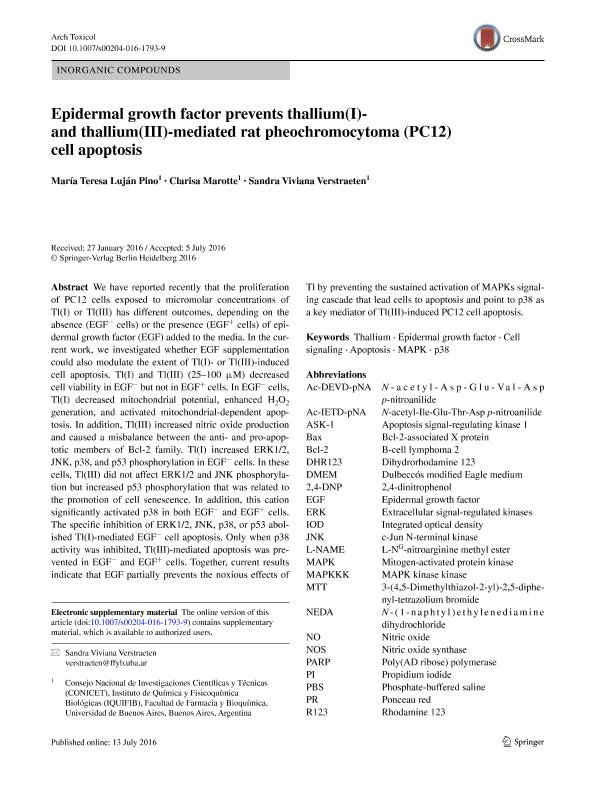Mostrar el registro sencillo del ítem
dc.contributor.author
Pino, María Teresa Luján

dc.contributor.author
Marotte, Clarisa

dc.contributor.author
Verstraeten, Sandra Viviana

dc.date.available
2018-06-05T18:10:21Z
dc.date.issued
2017-03
dc.identifier.citation
Pino, María Teresa Luján; Marotte, Clarisa; Verstraeten, Sandra Viviana; Epidermal growth factor prevents thallium(I)- and thallium(III)-mediated rat pheochromocytoma (PC12) cell apoptosis; Springer; Archives of Toxicology; 91; 3; 3-2017; 1157-1174
dc.identifier.issn
0340-5761
dc.identifier.uri
http://hdl.handle.net/11336/47339
dc.description.abstract
We have reported recently that the proliferation of PC12 cells exposed to micromolar concentrations of Tl(I) or Tl(III) has different outcomes, depending on the absence (EGF− cells) or the presence (EGF+ cells) of epidermal growth factor (EGF) added to the media. In the current work, we investigated whether EGF supplementation could also modulate the extent of Tl(I)- or Tl(III)-induced cell apoptosis. Tl(I) and Tl(III) (25–100 μM) decreased cell viability in EGF− but not in EGF+ cells. In EGF− cells, Tl(I) decreased mitochondrial potential, enhanced H2O2 generation, and activated mitochondrial-dependent apoptosis. In addition, Tl(III) increased nitric oxide production and caused a misbalance between the anti- and pro-apoptotic members of Bcl-2 family. Tl(I) increased ERK1/2, JNK, p38, and p53 phosphorylation in EGF− cells. In these cells, Tl(III) did not affect ERK1/2 and JNK phosphorylation but increased p53 phosphorylation that was related to the promotion of cell senescence. In addition, this cation significantly activated p38 in both EGF− and EGF+ cells. The specific inhibition of ERK1/2, JNK, p38, or p53 abolished Tl(I)-mediated EGF− cell apoptosis. Only when p38 activity was inhibited, Tl(III)-mediated apoptosis was prevented in EGF− and EGF+ cells. Together, current results indicate that EGF partially prevents the noxious effects of Tl by preventing the sustained activation of MAPKs signaling cascade that lead cells to apoptosis and point to p38 as a key mediator of Tl(III)-induced PC12 cell apoptosis.
dc.format
application/pdf
dc.language.iso
eng
dc.publisher
Springer

dc.rights
info:eu-repo/semantics/openAccess
dc.rights.uri
https://creativecommons.org/licenses/by-nc-sa/2.5/ar/
dc.subject
Apoptosis
dc.subject
Cell Signaling
dc.subject
Epidermal Growth Factor
dc.subject
Thallium
dc.subject
Mapk
dc.subject
P38
dc.subject.classification
Otras Ciencias de la Salud

dc.subject.classification
Ciencias de la Salud

dc.subject.classification
CIENCIAS MÉDICAS Y DE LA SALUD

dc.title
Epidermal growth factor prevents thallium(I)- and thallium(III)-mediated rat pheochromocytoma (PC12) cell apoptosis
dc.type
info:eu-repo/semantics/article
dc.type
info:ar-repo/semantics/artículo
dc.type
info:eu-repo/semantics/publishedVersion
dc.date.updated
2018-06-04T17:12:11Z
dc.journal.volume
91
dc.journal.number
3
dc.journal.pagination
1157-1174
dc.journal.pais
Alemania

dc.journal.ciudad
Berlin
dc.description.fil
Fil: Pino, María Teresa Luján. Consejo Nacional de Investigaciones Científicas y Técnicas. Oficina de Coordinación Administrativa Houssay. Instituto de Química y Físico-Química Biológicas "Prof. Alejandro C. Paladini". Universidad de Buenos Aires. Facultad de Farmacia y Bioquímica. Instituto de Química y Físico-Química Biológicas; Argentina
dc.description.fil
Fil: Marotte, Clarisa. Consejo Nacional de Investigaciones Científicas y Técnicas. Oficina de Coordinación Administrativa Houssay. Instituto de Química y Físico-Química Biológicas "Prof. Alejandro C. Paladini". Universidad de Buenos Aires. Facultad de Farmacia y Bioquímica. Instituto de Química y Físico-Química Biológicas; Argentina
dc.description.fil
Fil: Verstraeten, Sandra Viviana. Consejo Nacional de Investigaciones Científicas y Técnicas. Oficina de Coordinación Administrativa Houssay. Instituto de Química y Físico-Química Biológicas "Prof. Alejandro C. Paladini". Universidad de Buenos Aires. Facultad de Farmacia y Bioquímica. Instituto de Química y Físico-Química Biológicas; Argentina
dc.journal.title
Archives of Toxicology

dc.relation.alternativeid
info:eu-repo/semantics/altIdentifier/doi/https://dx.doi.org/10.1007/s00204-016-1793-9
dc.relation.alternativeid
info:eu-repo/semantics/altIdentifier/url/https://link.springer.com/article/10.1007%2Fs00204-016-1793-9
Archivos asociados
